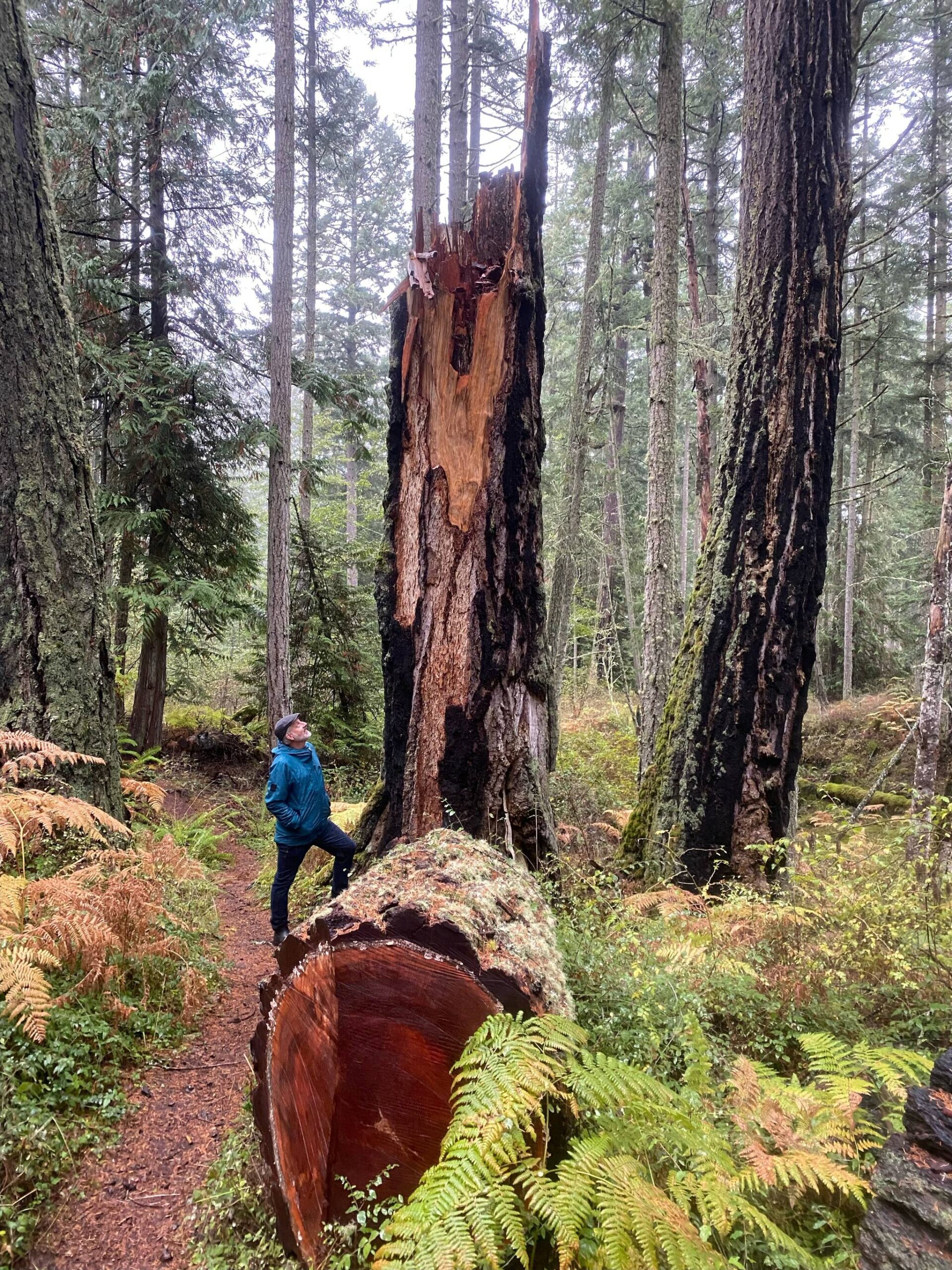By Isabel Ashley, reporter
In the summer of 2022, San Juan Island residents were hiking one of the trails at Mt. Grant Preserve when they came across a mammoth Douglas Fir that had fallen and subsequently blocked their path. Unsure of how to get around the tree, they called the San Juan County Conservation Land Bank, where they were volunteers. After investigating the situation and realizing it was a job for more than one person, Land Bank preserve steward Doug McCutchen enlisted the help of additional volunteers to move and stabilize the tree.
“As we were opening the trail back up, we spent several hours making sure we did this in a really safe way, so no one got squished if it decided to roll. [The tree] is many thousands of pounds,” said McCutchen.
During this process, a four-inch wide section was cut out of the trunk, rolled down the trail and smoothed with tools for the purpose of counting its rings. According to their count, McCutchen estimates that the tree is nearly 450 years old. The tree toppled over simply due to old age and structural compromise. The innermost part of trees, also known as heartwood, is a structural, non-living component – similar to bones in humans. This tree had evidence of heart rot, leading to its downfall.
“It is not unusual for long-lived trees to have wounds from events like wind storms, ice storms and fires, which entry for a pathogen or fungi, leading to rot,” said McCutchen. “Once that gets significant enough, it may be something as simple as drying in the summer or some little event – a small wind storm, an eagle sitting on the wrong part of the tree – and off it goes.”
Clearing trails and protecting several land preserves is just one facet of the Land Bank’s work. Started in 1990 by islanders who secured funding through state legislation, the county-run land conservation organization engages in low-intensity recreation and ecological, agricultural, historical and cultural preservation.
The Land Bank is the only county-run conservation organization in the state and is comprised of several well-known areas such as the Westside preserves and pullouts, Deadman Bay, Lime Kiln, Beaverton Marsh Preserve and Zylstra Lake Preserve.
The Land Bank has several ongoing projects on Mt. Grant in collaboration with other land managers on the island and the Washington Department of Natural Resources, such as a landscape restoration project involving forest thinning to improve fire safety and planting native species to enhance the west side of the preserve. The Land Bank is also partnering with the Conservation Corps for their biochar project, which is one of the largest biochar projects that has been undertaken in North America.
“Biochar is charcoal; fires are set in such a way that you get everything burning at the same time and rate and then extinguish it,” said McCutchen. “By doing that, you get everything into a charcoal form and it’s a great way to sequester carbon and improve soil health.”
This winter, the Land Bank hopes to hold an opening ceremony to celebrate the new trail network on Mt. Grant once the trails, parking and signage are finished. Initiated in 2018, McCutchen believes that thousands of hours is not an overestimate of time invested into the creation and design of the 5.5 miles of trail network, noxious weed control and habitat restoration.
“As we designed these trails with staff and volunteers, they were intended to tell a story….These are public spaces for people to have a connection to this amazing place where we live,” said McCutchen.
And trees such as this one hold a plethora of stories and information to be shared. Dendrochronologists – scientists who study tree rings – from Western Washington University have expressed interest in surveying the sample taken by McCutchen from the tree’s trunk. The tree’s rings can give insight into things such as climate records, difficult growing years, fire history and environmental history of the site. All of these elements can give a better picture of what this land was like hundreds of years ago and help us understand the changes and their impacts on the environment.
“There are stories all around here [and] these trees are a really important part of it,” said McCutchen. “Our forests were really different historically. The rings on this tree – how quickly it grew, how slowly it grew – tell a story about the environment in which it was based. These trees are a really great opportunity to really see the uniqueness of this site.”




